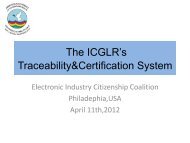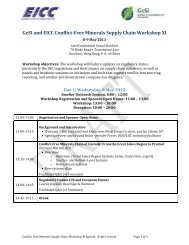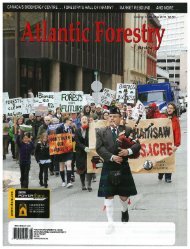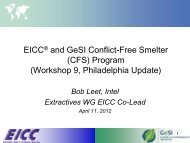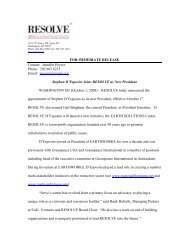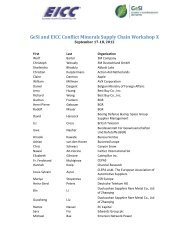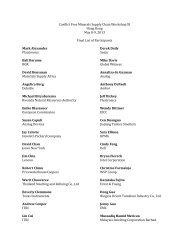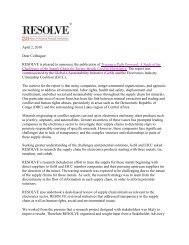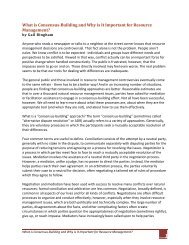Toward SuSTainabiliTy: The roleS and limiTaTionS of ... - Resolve
Toward SuSTainabiliTy: The roleS and limiTaTionS of ... - Resolve
Toward SuSTainabiliTy: The roleS and limiTaTionS of ... - Resolve
You also want an ePaper? Increase the reach of your titles
YUMPU automatically turns print PDFs into web optimized ePapers that Google loves.
Chapter1Setting the ContextTo set the stage for the chapters that follow, this chapter describes briefly the emergence<strong>of</strong> the st<strong>and</strong>ards <strong>and</strong> certification movement, the current status <strong>of</strong> some <strong>of</strong> the leadingst<strong>and</strong>ards <strong>and</strong> certification systems, the components or design features that make up mostsystems, <strong>and</strong> some <strong>of</strong> the challenges those systems face today.But first, some definitions. St<strong>and</strong>ards are adefined set <strong>of</strong> social, environmental, <strong>and</strong>/or economiccriteria. By complying with these criteria,enterprises translate a st<strong>and</strong>ard into concretepractices. Certification is a means <strong>of</strong> providingassurance that products or services comply withthe criteria. St<strong>and</strong>ards <strong>and</strong> certification systemsmay have many objectives, but at their most basicthey provide a framework through which differententities (e.g., nongovernmental organizations(NGOs), businesses, government, etc.) can cooperateusing a common language to deliver moresustainable practices.<strong>The</strong> Emergence <strong>of</strong> St<strong>and</strong>ards<strong>and</strong> Certification SystemsPrivate, voluntary st<strong>and</strong>ards for sustainable productionemerged long before a link was madeto certification. In fact, st<strong>and</strong>ards for organicagriculture were developed as early as the 1920s.<strong>The</strong>se st<strong>and</strong>ards represented the translation <strong>of</strong> aphilosophical approach to agriculture into a set<strong>of</strong> st<strong>and</strong>ardized growing practices. <strong>The</strong> st<strong>and</strong>ardsemerged from bottom-up, local st<strong>and</strong>ards thathad developed independently around the world,led mainly by groups <strong>of</strong> farmers themselves.Over time, these local st<strong>and</strong>ards were broughttogether, <strong>and</strong> a more unified, though not identical,interpretation <strong>of</strong> organic agriculture <strong>and</strong> theprinciples <strong>and</strong> criteria underlying it emerged. <strong>The</strong>International Federation <strong>of</strong> Organic AgricultureMovements (IFOAM) was established in 1972 asa communications network among the variousorganic agriculture initiatives. 1This approach to st<strong>and</strong>ards development—wherein multiple, locally developed st<strong>and</strong>ardscoalesced to create a common st<strong>and</strong>ard—wasa product <strong>of</strong> the early stages <strong>of</strong> the st<strong>and</strong>ardsmovement <strong>and</strong> occurs in only a couple <strong>of</strong> otherinstances, notably fair trade (Colitt, 1995) <strong>and</strong>sustainable tourism. <strong>The</strong> fair trade movementevolved in the early 1990s from a well-establishedEuropean network <strong>of</strong> shops that specializedin direct trading relationships. <strong>The</strong> FairtradeLabelling Organizations International (FLO) wasestablished in 1997 to bring together variousnational initiatives under one ro<strong>of</strong>. Fair tradecertification focused initially on agricultural commoditiesthat were critical to small farmers <strong>and</strong>workers, including c<strong>of</strong>fee, tea, cocoa, <strong>and</strong> sugar. Ithas been exp<strong>and</strong>ing to include other agricultural<strong>and</strong> non-agricultural commodities.In contrast to these examples, most other sustainableproduction st<strong>and</strong>ards emerged as the result<strong>of</strong> a conscious effort by a small group <strong>of</strong> nonpr<strong>of</strong>itorganizations to convene <strong>and</strong> engage a crosssection<strong>of</strong> stakeholders within a given sector,most notably bringing retailers <strong>and</strong> manufacturersto the negotiating table. <strong>The</strong> first attempt toimplement this new approach came with theestablishment <strong>of</strong> the Forest Stewardship Council(FSC) in 1993. <strong>The</strong> FSC built in part on the work<strong>of</strong> the Rainforest Alliance’s SmartWood program,which had been established a few years earlier1 www.ifoam.org/about_ifoam/inside_ifoam/history.html<strong>Toward</strong> Sustainability: <strong>The</strong> Roles <strong>and</strong> Limitations <strong>of</strong> Certification 6



